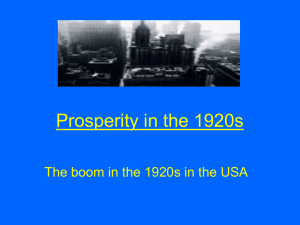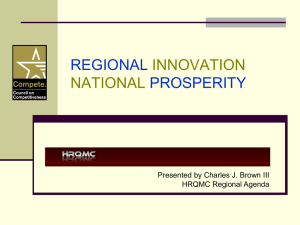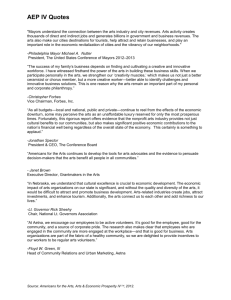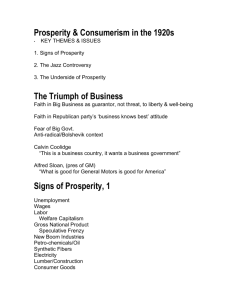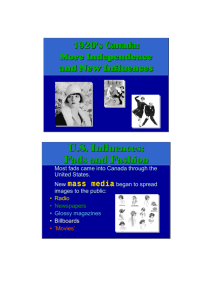Collected Commentary, economic prosperity in the 1920s
advertisement
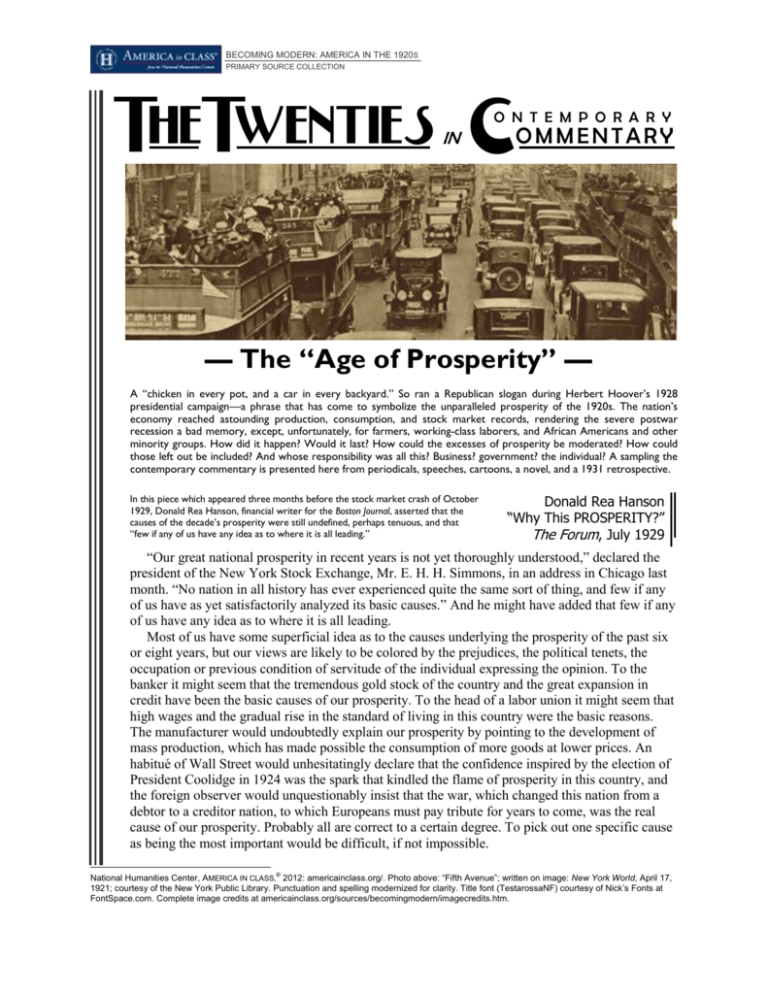
BECOMING MODERN: AMERICA IN THE 1920S PRIMARY SOURCE COLLECTION THETWENTIES C O N T E M P O R A R Y IN OMMENTARY * — The “Age of Prosperity” — A “chicken in every pot, and a car in every backyard.” So ran a Republican slogan during Herbert Hoover’s 1928 presidential campaign—a phrase that has come to symbolize the unparalleled prosperity of the 1920s. The nation’s economy reached astounding production, consumption, and stock market records, rendering the severe postwar recession a bad memory, except, unfortunately, for farmers, working-class laborers, and African Americans and other minority groups. How did it happen? Would it last? How could the excesses of prosperity be moderated? How could those left out be included? And whose responsibility was all this? Business? government? the individual? A sampling the contemporary commentary is presented here from periodicals, speeches, cartoons, a novel, and a 1931 retrospective. In this piece which appeared three months before the stock market crash of October 1929, Donald Rea Hanson, financial writer for the Boston Journal, asserted that the causes of the decade’s prosperity were still undefined, perhaps tenuous, and that “few if any of us have any idea as to where it is all leading.” Donald Rea Hanson “Why This PROSPERITY?” The Forum, July 1929 “Our great national prosperity in recent years is not yet thoroughly understood,” declared the president of the New York Stock Exchange, Mr. E. H. H. Simmons, in an address in Chicago last month. “No nation in all history has ever experienced quite the same sort of thing, and few if any of us have as yet satisfactorily analyzed its basic causes.” And he might have added that few if any of us have any idea as to where it is all leading. Most of us have some superficial idea as to the causes underlying the prosperity of the past six or eight years, but our views are likely to be colored by the prejudices, the political tenets, the occupation or previous condition of servitude of the individual expressing the opinion. To the banker it might seem that the tremendous gold stock of the country and the great expansion in credit have been the basic causes of our prosperity. To the head of a labor union it might seem that high wages and the gradual rise in the standard of living in this country were the basic reasons. The manufacturer would undoubtedly explain our prosperity by pointing to the development of mass production, which has made possible the consumption of more goods at lower prices. An habitué of Wall Street would unhesitatingly declare that the confidence inspired by the election of President Coolidge in 1924 was the spark that kindled the flame of prosperity in this country, and the foreign observer would unquestionably insist that the war, which changed this nation from a debtor to a creditor nation, to which Europeans must pay tribute for years to come, was the real cause of our prosperity. Probably all are correct to a certain degree. To pick out one specific cause as being the most important would be difficult, if not impossible. * National Humanities Center, AMERICA IN CLASS,® 2012: americainclass.org/. Photo above: “Fifth Avenue”; written on image: New York World, April 17, 1921; courtesy of the New York Public Library. Punctuation and spelling modernized for clarity. Title font (TestarossaNF) courtesy of Nick’s Fonts at FontSpace.com. Complete image credits at americainclass.org/sources/becomingmodern/imagecredits.htm. Frederick Lewis Allen Only Yesterday: An Informal History of the Nineteen Twenties, 1931 Calling himself a “retrospective journalist,” Allen published an informed and widely popular narrative of the 1920s just two years after the stock market crash. Why did it happen? What made the United States so prosperous? Some of the reasons were obvious enough. The war had impoverished Europe and hardly damaged the United States at all; when peace came the Americans found themselves the economic masters of the world. Their young country, with enormous resources in materials and in human energy and with a wide domestic market, was ready to take advantage of this situation. It had developed mass production to a new point of mechanical and managerial efficiency. The Ford gospel of high wages, low prices, and standardized manufacture on a basis of the most minute division of machine-tending labor was working smoothly not only at Highland Park [Michigan], but in thousands of other factories. Executives, remembering with a shudder the piled-up inventories of 1921, had learned the lesson of cautious hand-to-mouth buying; and they were surrounded with more expert technical consultants, research men, personnel managers, statisticians, and business forecasters than ever before invaded that cave of the winds, the conference room. Their confidence was strengthened by their almost invincible ally. And they were all of them aided by the boom in the automobile industry. The phenomenal activity of this one part of the body economicwhich was responsible, directly or indirectly, for the employment of nearly four million menpumped new life into all the rest. Prosperity was assisted, too, by two new stimulants to purchasing, each of which mortgaged the future but kept the factories roaring while it was being injected. The first was the increase in the installment buying. People were getting to consider it old-fashioned to limit their purchases to the amount of their cash balance; the thing to do was to “exercise their credit.” By the latter part of the decade, economists figured that fifteen percent of all retail sales were on an installment basis, and that there were some six billions of “easy payment” paper outstanding. The other stimulant was stock market speculation. When stocks were skyrocketing in 1928 and 1929 it is probable that hundreds of thousands of people were buying goods with money which represented, essentially, a gamble on the business profits of the nineteen-thirties. It was fun while it lasted. Pres. Warren Harding and his cabinet, ca. 1921-1923 Library of Congress The Twenties Presidents on PROSPERITY WARREN HARDING Inaugural Address, March 4, 1921 EXCERPTS The forward course of the business cycle is unmistakable. Peoples are turning from destruction to production. Industry has sensed the changed order and our own people are turning to resume their normal, onward way. The call is for productive America to go on. I know that Congress and the Administration will favor every wise Government policy to aid the resumption and encourage continued progress. . . . . . . I would like to acclaim an era of good feeling amid dependable prosperity and all the blessings which attend. . . . We would not have an America living within and for herself alone, but we would have her self-reliant, independent, and ever nobler, stronger, and richer. Believing in our higher standards, reared through constitutional liberty and maintained opportunity, we invite the world to the same heights. But pride in things wrought is no reflex of a completed task. Common welfare is the goal of our national endeavor. Wealth is not inimical to welfare; it ought to be its friendliest agency. There never can be equality of rewards or possessions so long as the human plan contains varied talents and differing degrees of industry and thrift, but ours ought to be a country free from the great blotches of distressed poverty. We ought to find a way to guard against the perils and penalties of unemployment. . . . There is no shortcut to the making of these ideals into glad realities. The world has witnessed again and again the futility and the mischief of ill-considered remedies for social and economic disorders. But we are mindful today as never before of the friction of modern industrialism, and we must learn its causes and reduce its evil consequences by sober and tested methods. Where genius has made for great possibilities, justice and happiness must be reflected in a greater common welfare. National Humanities Center Contemporary Commentary on the 1920s: The “Age of Prosperity” 2 Stuart Chase “Why Business Prosperity Came” Ch. 3, Prosperity: Fact or Myth?, 1929 An early consumer activist, Chase was cofounder with Frederick Schlink of Consumers Research, Inc., the first product-testing organization in America. Their 1927 bestseller, Your Money’s Worth, which exposed manipulative marketing practices, was an early Book-of the-Month selection. [P]rosperity, from the businessman’s point of view, has certainly been with usat least with part of usfor the past eight years. The price structure has been stable; corporation earnings have been increasing. Productivity per man has made phenomenal gains; the national income, both in total and per capita, grows greater every year. But the picture also has its darker side. Many items either showed no gain, or even headed downward. Indeed, it is all too obvious by now that the hullaballoo of the prosperity chorus has been considerably overdone. Like all good optimism since the world began, the chorus has concentrated on the highlights and forgotten the more somber shadows. Discounting the excess of optimism, enough remains to be worth a shout or two, and more than enough to whet our curiosity as to how it has come about. What forces have been gathering since 1921 to make this commercial prosperity the very sizeable thing it is and to attract foreign savants by the shipload for its measurement and study? THE SIX-CYLINDER COMPLEX To my mind, the largest single force has been the motor car. The automobile was something which people really wanted with a desire that amounted to a passion. The effect was two-fold. It stimulated business, and it suffused the country with the visible appearance of a prosperity in which everybody seemed to share. Other prosperous periods have been stimulated by foreign trade, or by the seeping of gold into the community. But this particular period was stimulated by a large, active, noisy, and inescapable article visible on every road. You could see, hear, smell monster for miles. (Some 25,000 unfortunates are touched by it each year, never to breathe again.) Something in the nature of 500 millions of horsepower was given over to the ultimate consumer in a remarkably short space of timethe biggest single block of power, by many fold, which the world has ever delivered. It sent the credit structure spiraling upward, and it certainly made us look prosperous. When Henry Ford and the installment contract brought the cost of the automobile down to negotiable terms, it became something that people were willing to work for, save for, strive for. It promised three great gifts dear to the human State Library & Archives of Florida heart: romantic adventure, social standing, and the joy of rushing through the air (the urge upon which operators of roller coasters and shoot-the-chutes thrive). A car! My car!! Is there a mathematics with a slide rule long enough to compute the total emotional force which these two phrases have touched off in the last decade? . . . But most of us have not tired of this gorgeous toy. Its appeal strikes deep into our innermost natures. It has captured our psychological interest, as nothing has ever done before, and as perhaps nothing will ever do Young man and his Chevrolet, St. Petersburg, Florida, November 1924 again. It is the outstanding Why “It is the outstanding Why of American Prosperity of American prosperityboth —both commercial and visible.” commercial and visible. National Humanities Center Contemporary Commentary on the 1920s: The “Age of Prosperity” 3 Thomas Jefferson Wertenbaker “What’s Wrong with the United States?” Scribner’s, October 1928 Wertenbaker was an American historian at Princeton University. In short, the result has been that in this country today human beings have reached a higher state of material welfare than in any other era of world history or in any other nation of the world. I know that some will say, “It is for these very things that we are criticized. We have been accused of worshipping material gain to the neglect of literature, art, music, and science.” But, after all, is not the material more fundamental? What boots it if we produce a Shakespeare or a Michelangelo, if there are millions living in misery and degradation? . . . . . . Some of these criticisms [of American prosperity] are inspired by ignorance or jealousy, others are matters of controversy, still others are trivial. Some, beyond question, are sound in character, and point to real defects in our system, real dangers for the future. But let us not lose our proper prospective because of the present volley of abuse. We may agree that unrestricted immigration has produced a very real problem, that undirected reproduction has its dangers, that there is need for curbing crime in our large cities, that there are too many boxlike little cottages spread out over the country, that our fellow citizens are sometimes aggressive and a bit trying when they visit foreign countries. But let us pity those critics who see nothing beyond these blemishes, when the most amazing spectacle in all history stretches out before their eyesthe chaining of the forces of nature, the freeing of man from the bondage of killing labor, the creation of a huge surplus above the needs of the hour and its diversion to the higher and better things of life, not only to greater comforts and opportunities for the individual, but to education, to research, to literature, to art. After all, we have a right to view with pride a past of splendid accomplishment; to look forward with confidence to a future of unprecedented promise and hope. Library of Congress The Twenties Presidents on PROSPERITY CALVIN COOLIDGE Address at the 15th Meeting of the Business Organization of the Government June 11, 1928, EXCERPTS I have rejoiced in keeping down the annual budget, in reducing taxes, and paying off the national debt, because the influence of such action is felt in every home in the land. It has meant that the people not only have greater resources with which to provide themselves with food and clothing and shelter, but also for the enjoyment of what was but lately considered the luxuries of the rich. We call these results prosperity. They have come because the people have been willing to do their duty. They have refrained from waste, they have shunned extravagance. . . . It would be unfortunate, however, if out of these discussions the impression should be gained that it is the obligation of the Government to furnish the people with prosperity. They are entitled to such an administration of their affairs as will give them every fair opportunity, but it should always be remembered that if there is to be prosperity they must furnish it for themselves. . . . It all depends upon what use is made of the rewards of success. . . . It is always possible to use them extravagantly and in disreputable ways. It is also possible to use them as the main supports of the real progress of enlightened civilization. Prosperity is only an instrument to be used, not a deity to be worshiped. . . . The industry and trade of the United States in 1921 were suffering from grave depression. They had been severely affected by the inevitable reaction from the war period. Our foreign trade was experiencing a great decline. Production had been sharply restricted. . . . There is a striking contrast between those dark days of 1921 and the remarkably favorable position of our trade industry today. It is the human element in the situation that deserves to be stressed first, and here the question of unemployment comes strongly to the front. In July 1921, more than 5,700,000 people were without work in the United States. At the present time, according to the most careful computation by the Department of Labor, the number is not much more than 1,800,000, nearly half of whom are normally to be expected as temporarily unemploy[ed] while in transit from one position to another. Pres. Coolidge with delegates to the Conference of the Republican National Committee Women, January 12, 1927 National Humanities Center Contemporary Commentary on the 1920s: The “Age of Prosperity” 4 Daisy Worthington Worcester Address, Natl. Conference of Social Work, June 18, 1929 This myth of prosperity, if believed, will lead to inevitable catastrophe. America’s prosperity is for only twenty-four percent of the people, and this percentage owns all the wealth of this country. . . . In the time this excess has been accumulating, public charities have increased their expenditures 132 percent. W. E. B. Du Bois, “The Shape of Fear” The North American Review June 1926 Or again; why is it that in a rich country like the United States, in many respects the richest and most prosperous organization of men in the world, we continually have mobs fighting and doing unutterable things because at bottom men are afraid of being unable to earn a respectable living? The answer is that our postwar prosperity is built more on gambling than on honest productive industry. Gambling was the result of war, born in wartime and coming from the sudden demand for technique machinery and goods, which paid those who happened to hold them enormous marginal rents. The chance to the gambler, the promoter and the manipulator of industry has come during the reconstruction since the war, in the monopoly of land and homes, in the manipulation of industrial power, in the use of new inventions and discoveries, in the reorganization of corporate ownership. We have today in the United States, cheek by jowl, Prosperity and Depression. Depression among those who are selling their services, raising raw material, and manufacturing goods; prosperity among those who are manipulating prices, monopolizing land and mortgaging ability and output. Arthur Capper “Victimizing the Farmer” The Forum, April 1924 “The Farmer’s Predicament” Chicago Tribune, April 15, 1927 Arthur Capper was a U.S. Senator from Kansas for thirty years, from 1919 to 1949. The greatest assistance that can be given agriculture is to evolve an effective program for raising prices of farm products to a parity with city prices, for the farmer will never regain prosperity until farm products sell as high with “It’s Hard to Fool Those Backstage” The Pittsburgh Courier, African American newspaper, June 13, 1925 National Humanities Center Contemporary Commentary on the 1920s: The “Age of Prosperity” 5 relation to the general price level as before the war. This does not mean upsetting our economic system, or the guaranteeing of prices by the government, but a sound and practical marketing system that will put the government in support of a businesslike marketing program . . . The farmer today is at the mercy of any violent price upheaval. It is impossible for him to meet business or labor on an equal basis. All the farmer asks is like privileges with labor and business. The farm problem cannot be solved until he is given a voice in determining the price of his product. “Prosperity—for Whom?” editorial, The Nation February 28, 1925 Where then is the average man’s share of the prosperity promised in the election of Mr. Coolidge? It has not arrived and it is not discernible on the horizon. But when the stock boom spends itself and deflation sets in, the average citizen will be invited, as usual, to sustain the losses. The Twenties Presidents on PROSPERITY HERBERT HOOVER Republican Presidential Candidate Campaign Speech, October 22, 1928 EXCERPTS As a nation we came out of the war with great losses. We made no profits from it. The apparent increases in wages were fictitious. We were poorer as a nation when we emerged from it. Yet during these last eight years we have recovered from these losses and increased our national income by over one third even if we discount the inflation of the dollar. While some individuals have grown rich, yet that there has been a wide diffusion of our gain in wealth and income is marked by a hundred proofs. I know of no better test of the improved conditions of the average family than the combined increase of life and industrial insurance, building and loan assets, and savings deposits. These are the financial agents of the average man. These alone have in seven years increased by nearly 100 percent to the gigantic sum of over fifty billions of dollars, or nearly one sixth of our whole national wealth. . . . Today there are almost nine automobiles for each ten families, where seven and a half years ago only enough automobiles were running to average less than four for each ten families. The slogan of progress is changing from the full dinner pail to the full garage. Our people have more to eat, better things to wear, and better homes. . . . We have decreased the fear of old age, the fear of poverty, the fear of unemployment and these are fears which have always been amongst the greatest calamities of human kind. . . . I do not need to recite more figures and more evidence. There is not a person within the sound of my voice that does not know the profound progress which our country has made in this period. Every man and woman knows that their comfort, their hopes and their confidence for the future are higher this day than they were seven and one-half years ago. . . . One of the great problems of government is to determine to what extent the government itself shall interfere with commerce and industry and how much it shall leave to individual exertion. It is just as important that business keep out of government as that government keep out of business. No system is perfect. We have had abuses in the conduct of business that every good citizen resents. But I insist that the results show our system better than any other and retains the essentials of freedom. “Prosperity? Blah!!” Public Ledger, Philadelphia [n.d.] as reprinted in the Los Angeles Times, Sept. 14, 1926 As a result of our distinctly American system our country has become the land of opportunity to those born without inheritance not merely because of the wealth of its resources and industry but because of this freedom of initiative and enterprise. Russia has natural resources equal to ours. Her people are equally industrious but she has not had the blessings of 150 years of our form of government and of our social system. National Humanities Center Contemporary Commentary on the 1920s: The “Age of Prosperity” 6 Hoover Presidential Library/U.S. National Archives political advertisement, Republican Business Men, Inc. [NY], 1928 Al Smith, Democratic Presidential Candidate Nomination Acceptance Address August 22, 1928 The Republican Party builds its case upon a myth. We are told that only under the benevolent administration of that party can the country enjoy prosperity. When four million men, desirous to work and support their families, are unable to secure employment, there is very little in the picture of prosperity to attract them and the millions dependent upon them. In the year 1926, the latest figures available show that one twentieth of one percent of the 430,000 corporations in this country earned forty percent of their profits; forty percent of the corporations actually lost money; one fourth of one per cent of these corporations earned two thirds of the profits of all of them. Specific industries are wholly prostrate and there is widespread business difficulty and discontent among the individual businessmen of the country. Prosperity to the extent that we have it is unduly concentrated and has not equitably touched the lives of the farmer, the wage earner, and the individual businessman. The claim of governmental economy is as baseless as the claims that general business prosperity exists and that it can exist only under Republican administration. National Humanities Center Contemporary Commentary on the 1920s: The “Age of Prosperity” 7 Henry Louis Mencken “Civil War in the Confederacy” The [Baltimore] Evening Sun, July 30, 1928 Famed for his sardonic commentary on everything he deemed lowbrow, especially in the American South, journalist H. L. Mencken noted with astonishment the effect of twenties prosperity on the region, especially on the “Young South.” The thing that is changing the South is prosperity. So long as the overwhelming majority of its people were poor, as they were until a decade or so ago, they had to stay in their wallows, and no glimmer of enlightenment ever reached them. Their schools, in the main, were fifth-rate, and they had few intelligent newspapers. . . . It became dangerous in the South to be intelligent. The whole region seemed to be plunged in imbecility, and without hope of getting out. Every Baptist pastor became a neighborhood pope. The Anti-Saloon League was supreme in politics. The Klan elected Governors and Senators. Thousands of young Southerners, in despair, moved North. But with the end of the war came a swift reaction, and on its heels prosperity. Boys and girls began to flock to college. With money in their treasuries, the states overhauled their school systems. Newspapers began to make money, and with money came boldness. Soon leaders made their appearanceHarris in Georgia, Hall in Alabama, Wight in South Carolina.* The Klan, drunk with power, committed suicide. The Anti-Saloon League, going from excess to excess, aroused its opponents to action. In a few years there was a complete change. The Young South began to be heard from, demanding an end of abominations, social, religious, and political. Louis I. Dublin “Life, Death, and the Negro” American Mercury, September 1927 Louis Dublin was a white statistician specializing in public health issues including infant mortality, childhood disease, and life span. In this essay he provided detailed analysis of the progress of African Americans’ health since emancipation. A striking evidence of the new prosperity of the South is the freshness and activities of the towns and villages where Negroes live. Roads, new homes, and schools and churches are being built on an immense scale. Banks, managed by Negroes for Negroes, are increasing in number, and the savings on deposit are mounting. These are powerful factors in improving the status of the Negro. A new consciousness of power and of worthwhileness is everywhere manifested. There is evidence of intelligent leadership directing the energies of the young people into constructive channels. The number of children at school and of teachers in training is rapidly increasing. Probably no single American group is experiencing so deep and so intelligent a revival of latent power as is the Negro today. Clarence Darrow The Story of My Life 1932 Renowned and reviled for taking controversial underdog cases, defense attorney Clarence Darrow voiced his political and philosophical judgment of the tumultuous twenties in his memoir, published in the worst year of the Great Depression, 1932. It required no wizard or even genius to foresee the end. The collapse of the dream is now history. In spite of the fact that government officials tried everything in their power to lure the businessmen and the capitalists to risk their money, to stimulate circulation, and put new life into the dead, it was of no avail. When the pulmotor [resuscitator] is taken to the sufferer it is almost invariably followed by the hearse. It was soon evident that the holdings and investments of the small and common man had been swept away. The effect on all business was practically automatic. It meant the loss and lack of employment, lower wages, less buying power, and general distress. The experience taught one lesson, that no one wants to learn: the ease of production, the folly of poverty in a world well able to furnish plenty for all, a world where abundance might and should prevail. But it has not taught the managers of industry, of business and politics, that the great problem of prosperity no longer depends on the production of wealth, but on its distribution. Without converting the world to any fantastic doctrines or distant dreams, a few men with the organizing ability of our Captains of Industry could easily and rapidly solve this problem if they could only be inspired with the desire to help their fellow man. * William Julius Harris: U.S. Senator (Dem.) from Georgia (1919-1932). Grover Cleveland Hall: liberal Alabama newspaper editor and Pulitzer-Prize winner for his editorials against intolerance. Wight: unidentified. National Humanities Center Contemporary Commentary on the 1920s: The “Age of Prosperity” 8 John Dos Passos The Big Money novel, 1936 A passionate writer in the modernist-leftist movement of the period, Dos Passos produced the trilogy of novels U.S.A. that chronicled twelve characters struggling to make their way in the economic maelstrom of the postwar era. Interspersed throughout the novels are “newsreels” comprised of news headlines, song lyrics, silent newsreel titles, etc., to encapsulate the working-class struggles and capitalist dominance within which Dos Passos’s characters could not thrive. This newreel cites several instances in which corporate greed and neglect of the public good were cited by critics as contributory to disaster. [Annotations added] __NEWSREEL LXVIII__ WALL STREET STUNNED This is not Thirty-eight but it’s old Ninety-seven You must put her in Center on time MARKET SURE TO RECOVER FROM SLUMP “Wreck of the Old ’97”: ballad inspired by a 1903 Virginia train wreck in which eleven died; lyrics lay blame on the railroad for ordering the engineer to speed in order to deliver the mail on schedule Decline in Contracts POLICE TURN MACHINE GUNS ON COLORADO MINE STRIKERS KILL 5 WOUND 40 Incident known as the Columbine Mine Massacre, November 1927 sympathizers appeared on the scene just as thousands of office workers were pouring out of the buildings at the lunch hour. As they raised their placard high and started an indefinite march from one side to the other, they were jeered and hooted not only by the officer workers but also by workmen on a building under construction NEW METHODS OF SELLING SEEN Rescue Crews Try To Upend Ill-fated Craft While Waiting For Pontoons He looked ’round an’ said to his black greasy fireman Jus’ shovel in a little more coal And when we cross that White Oak Mountain You can watch your Ninety-seven roll Eastland disaster of July 1915: capsize of top-heavy and overcrowded excursion boat at dockside in Chicago; over 800 people drowned, mostly workers on an annual company picnic “Wreck of the Old ’97” I find your column interesting and need advice. I have saved four thousand dollars which I want to invest for a better income. Do you think I might buy stocks? POLICE KILLER FLICKS CIGARETTE AS HE GOES TREMBLING TO DOOM PLAY AGENCIES IN RING OF SLAVE GIRL MARTS Maker of Love Disbarred as Lawyer Oh the right wing clothesmakers And the Socialist fakers They make by the workers. . . Double cross They preach Social-ism But practice Fasc-ism To keep capitalism By the boss period song criticizing the American Socialist Party in general, and specifically the Cloak Workers Union in New York Robert Conquest, The Dragons of Expectation (Norton, 2005) MOSCOW CONGRESS OUSTS OPPOSITION It’s a mighty rough road from Lynchburg to Danville An’ a line on a three mile grade It was on that grade he lost his average An’ you see what a jump he made “Wreck of the Old ’97” MILL THUGS IN MURDER RAID National Humanities Center Contemporary Commentary on the 1920s: The “Age of Prosperity” 9 here is the most dangerous example of how at the decisive moment the bourgeois ideology liquidates class solidarity and turns a friend of the working class of yesterday into a most miserable propagandist for imperialism today RED PICKETS FINED FOR PROTEST HERE We leave our home in the morning We kiss our children goodby OFFICIALS STILL HOPE FOR RESCUE OF MEN He was goin’ downgrade makin’ ninety miles an hour When his whistle broke into a scream He was found in the wreck with his hand on the throttle An’ was scalded to death with the steam “Mill Mother’s Lament”: labor song by union activist Ella May Wiggins, who was killed during the 1929 Gastonia, NC, textile mill strike, possibly by hired strikebreakers “Wreck of the Old ’97” RADICALS FIGHT WITH CHAIRS AT UNITY MEETING PATROLMEN PROTECT REDS U.S. CHAMBER OF COMMERCE URGES CONFIDENCE REAL VALUES UNHARMED While we slave for the bosses Our children scream an’ cry But when we draw our money Our grocery bills to pay “Mill Mother’s Lament” PRESIDENT SEES PROSPERITY NEAR Not a cent to spend for clothing Not a cent to lay away. “Mill Mother’s Lament” STEAMROLLER IN ACTION AGAINST MILITANTS MINERS BATTLE SCABS But we cannot buy for our children Our wages are too low Now listen to me you workers Both you women and men Let us win for them the victory I’m sure it ain’t no sin CARILLON PEALS IN SINGING TOWER the President declared it was impossible to view the increased advantages for the many without smiling at those who a short time ago expressed so much fear lest our country might come under the control of a few individuals of great wealth HAPPY CROWDS THRONG CEREMONY on a tiny island nestling like a green jewel in the lake that mirrors the singing tower, the President today participated in the dedication of a bird sanctuary and its pealing carillon, fulfilling the dream of an immigrant boy National Humanities Center Contemporary Commentary on the 1920s: The “Age of Prosperity” Scabs: men hired to replace striking workers “Mill Mother’s Lament” In 1929 Pres. Coolidge dedicated the Bok Tower Gardens in Florida, created by the former editor of the Ladies Home Journal, Edward Bok, the “immigrant boy” from the Netherlands who chronicled his rags-to-riches story in the best-selling memoir The Americanization of Edward Bok (1920). 10


